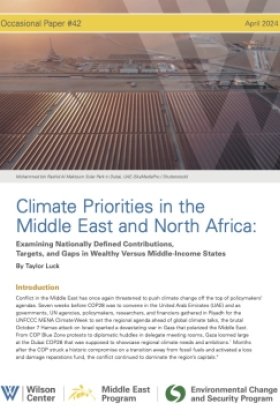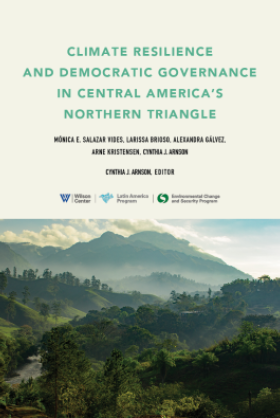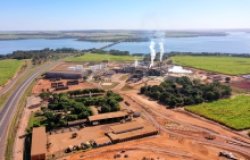Environmental Cooperation Between Hong Kong and Guangdong
Yok-Shiu F. Lee, The University of Hong Kong; Carlos Wing-Hung Lo, The Hong Kong Polytechnic University
Overview
By Linden J. Ellis and Jennifer L. Turner
Guangdong's industrialization and urbanization—driven largely by Hong Kong capital—has had a significant impact on the environment of the whole Pearl River Delta (PRD) region. Besides choking air pollution in the PRD, other major environmental problems are emerging around water quality of shared rivers and the growing number of cross-border infrastructure projects. Hong Kong and Guangdong have undertaken joint air quality studies and monitoring since 2002, and discussions on setting up a regional SO2 emissions trading scheme are underway, but collaboration on broader environmental issues are not as developed. At an April 29th CEF meeting, Yok-Shiu Lee (Hong Kong University) and Carlos Wing-Hung Lo (The Hong Kong Polytechnic University) discussed Hong Kong's emerging efforts to address cross-border environmental protection issues, highlighting proactive steps the Hong Kong government could take in formulating a region-wide policy regime to help manage regional infrastructure projects and drinking water resources under the rubric of sustainable development. Regional cooperation between Hong Kong and Guangdong notably represents a potential model for environmental collaboration in other regions of China.
CROSS BORDER ENVIRONMENTAL PROTECTION Hong Kong faces a unique challenge in that most of the city's air and water pollution originates from across the border in mainland China, rather than from its own industry. However, much of the industry in Guangdong depends on Hong Kong investment. Until recently, little cross-border pollution control cooperation has been taken place between Guangdong and Hong Kong due to constraints stemming from different political structures and a lack of joint research on the issues. The research conducted by Drs. Lo and Lee through Hong Kong University with Hong Kong government funding is thus unique and covers a wide range of topics including water pollution control, air pollution, transboundary environmental impact assessments, and, eventually e-waste issues. The research—spurred on by increasing environmental concern on both sides of the border—is intended to inform policy and chart a future path for cross-boundary cooperation both between Guangdong and Hong Kong, and between other provinces in China. Much of the research will be included in a book due out at the end of 2008 summarizing the results.
Hong Kong faces a unique challenge in that most of the city's air and water pollution originates from across the border in mainland China, rather than from its own industry. However, much of the industry in Guangdong depends on Hong Kong investment. Until recently, little cross-border pollution control cooperation has been taken place between Guangdong and Hong Kong due to constraints stemming from different political structures and a lack of joint research on the issues. The research conducted by Drs. Lo and Lee through Hong Kong University with Hong Kong government funding is thus unique and covers a wide range of topics including water pollution control, air pollution, transboundary environmental impact assessments, and, eventually e-waste issues. The research—spurred on by increasing environmental concern on both sides of the border—is intended to inform policy and chart a future path for cross-boundary cooperation both between Guangdong and Hong Kong, and between other provinces in China. Much of the research will be included in a book due out at the end of 2008 summarizing the results.
Regional Environmental Protection
Pollution is not restricted by political boundaries, but effective legislation can be. Dr. Lo noted that there are numerous models for regional collaboration on pollution control ranging from institutions with a strong formal legal base to ad hoc and informal cross-border initiatives. The appropriate model for regional cooperation depends on the nature and severity of pollution problems, but perhaps most importantly on perceptions of sovereignty among all participating countries or sub-national jurisdictions. Many good examples of cross-boundary cooperation exist in the Western world that could be a model for the Guangdong-Hong Kong collaboration, particularly the agreements between the United States and its neighbors to the north and south. Global trends in regional pollution control mechanisms are placing a growing emphasis on prevention, expanding from command and control to economic incentives, with the whole structure becoming more formal.
Situation in the PRD
In the Pearl River Delta (PRD), pollution is serious because of extensive manufacturing and heavy industries, many of which are joint ventures with Hong Kong or international investment. While cross-border air pollution receives considerable media attention, water pollution is also a serious shared issue. Regional dialogue and cooperation on pollution began in the 1990s, even including relatively progressive topics such as environmental impact assessments, but progress has been slow. Cooperation between Hong Kong and Guangdong on pollution has been ad hoc and consisted mostly of policy consultation and not on-the-ground projects. Besides the political differences between Hong Kong and Guangdong, another major constraint to long-term cooperation is Guangdong's reluctance to share data. Until recently, another obstacle has been a lack of public awareness in Guangdong on the regional pollution challenge. Notably citizens in Hong Kong are very aware of the regional nature of pollution problems in the PRD, however, awareness in Guangdong, particularly Shenzhen, is rising as people across the region are demanding higher quality of life, even at the expense of economic development. In fact, people in Shenzhen are now requesting information from Hong Kong on new, potentially polluting projects that may affect the pollution levels in Shenzhen.
A few years ago a specific office was established to handle cross-border pollution issues and a schedule for regular dialogue was established. Dr. Lo noted that after attending educational conferences in Hong Kong, China's Ministry of Environmental Protection has become much more interested in tackling regional pollution issues. Further, new leadership in Guangdong may open up new opportunities for collaboration as Guangzhou aims to be a model environmental city. However, both speakers stressed that the ideal model of cross-boundary legal structure with enforcement power is still a long way off.
DONG JIANG: WATER RESOURCES CONSERVATION AND BUREAUCRATIC CONFLICTS
Hong Kong relies on the Dong River, or Dongjiang, for 80 percent of its water for which it pays Guangdong a lump sum. The river travels through Jiangxi and Guangdong provinces before reaching Hong Kong and serves 45 million people daily. As industry in the PRD has increased and demand for water with it, even this relatively water-rich area is facing water quantity problems that exacerbate water pollution and spark tensions within the region.
Major Conflicts in the River Basin
The Dongjiang basin operates under what Yok-shiu Lee calls a "fragmented authoritarian model." Within the province the provincial government has the power to force a decision on lower governments along the basin, so when two local governments have a conflict they do not deal directly with each other, but rather appeal to and negotiate with the government body directly above them until a consensus is ostensibly mandated. If the environmental issue crosses provincial boundaries, the central government must mediate.
 Since the early 1980s this bargaining practice has been reinforced by increasing local autonomy of resources, giving localities greater bargaining power. Conflicts related to water use are useful in understanding this bargaining process because water constantly travels across borders and between sectors of the economy, and its pollution can be traced easily.
Since the early 1980s this bargaining practice has been reinforced by increasing local autonomy of resources, giving localities greater bargaining power. Conflicts related to water use are useful in understanding this bargaining process because water constantly travels across borders and between sectors of the economy, and its pollution can be traced easily.
Carlos Wing-Hung Lo explained that the central issues in the conflict hinge not merely on unclear water rights but also on starkly differing definitions of what parts of the river constitute the upstream and downstream. For example, from the perspective of Jiangxi officials and citizens, their province is the upstream user and therefore should be compensated by downstream users for keeping the water clean for the other 90 percent of the users are downstream. Guangzhou, however, considers the city of Heyuan in Guangdong Province the upstream user that should receive compensation for protecting the water.
Notably, the populations further upstream are progressively poorer. While Hong Kong at the mouth of the river generates an annual GDP of $27,680 per capita, Xunmu County in Jiangxi in the headwaters generates only $215 per capita annually. Xunmu attributes this disparity to foregone economic opportunity such as mining, industry and logging, which would affect the quantity and quality of the river for all other users. Additionally, to control the quantity of water reaching lower areas of the river and produce electricity, 3 major dams were built in Jiangxi in the late 1950s, displacing half a million farmers. Several decades later, these reservoir migrants have not adequately been compensated and continue to suffer poor housing conditions and lack of economic opportunities. It was only in 2006 that compensation for reservoir migrants was raised to 600 Yuan annually—previously the rate was 100 Yuan. Prior to 2006, loggers in Xunmu and other areas of Jiangxi whose forests were placed under state protection to ensure water quality for Guangdong and Hong Kong lost 37 Yuan per mu, forcing many to turn to illegal logging. Thus Jiangxi officials believe that they should receive financial "ecological compensation" from Hong Kong's and Guangdong's government.
However, questions of who should pay how much and for how long continue to plague discussions on protecting the river upstream. China lacks legislation for inter-provincial water conservation schemes and unclear water rights has meant water in rivers, such as the Dongjiang, is often wasted and not managed holistically. Thus, the potential for functioning payment for environmental services schemes are limited.
STEPS TOWARDS WATER CONSERVATION
Addressing water wastage could play a major role in helping to manage the Dongjiang sustainably. Thus, in order to help guarantee municipalities in the PRD clean water, the Guangdong provincial government has drawn up a water allocation plan, which is developing caps on water that can be withdrawn per city in order to limit total withdrawal to 30 percent of river flow. The current draft scheme allocates 1.1 billion cubic meters to Hong Kong, which currently only uses 800 million, implying that Hong Kong will be able to sell the extra water.
Currently there are three compensation schemes being designed to target concerns in Dongjiang's upstream within Guangdong Province, including: (1) reservoir migrants; (2) forest farmers who are no longer allowed to farm their trees; and (3) the city government of Heyuan. All are of these schemes are being financed by the Guangdong provincial government. Due to lack of clarity of water rights, the provincial government does not call the money given to Heyuan as "compensation" for water (which could imply a water user right by the upstream) and instead refers to it as poverty reduction aid. Additionally, Guangdong has developed an incentive program to move light industry such as mobile phone production into Heyuan to both stimulate the economy.
Xunmu County in Jiangxi is notably not included in any of Guangdong's compensation schemes. Additionally, Hong Kong remains aloof of the problem of upstream compensation, although Guangdong claims that the fee Hong Kong pays for its water use only covers the cost of delivering the water and not the cost of water conservation projects along the river. To draw attention to the disparity and improve their bargaining position, Jiangxi has invited Hong Kong and Guangdong journalists and TV stations to the poor counties. If upstream grievances are not met, Jiangxi may turn to industry to improve their economic conditions, or they may not cooperate with water conservation schemes demanded by the downstream users.
Hosted By

China Environment Forum
Since 1997, the China Environment Forum's mission has been to forge US-China cooperation on energy, environment, and sustainable development challenges. We play a unique nonpartisan role in creating multi-stakeholder dialogues around these issues. Read more
Thank you for your interest in this event. Please send any feedback or questions to our Events staff.









